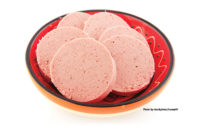Spicy Secrets


|
This is great news to formulators trying to clean up ingredient legends by removing chemical-sounding additives, regardless if they are artificial or natural. Depending upon the usage level and form, as well as the application, herbs and spices are either declared by name or sometimes simply as “natural flavor.”
Over the past 50 years, numerous investigations have shown that herbs and spices can effectively inhibit growth of foodborne bacteria and yeast. This antimicrobial activity is directly related to specific chemicals in the herb and spice, components typically concentrated in the oil fraction. For example, carvacrol, eugenol and thymol are phenol compounds that are found in cinnamon, cloves, oregano and sage. The essential-oil fraction is particularly high in cloves, and eugenol comprises 95% of the fraction, making cloves an excellent antimicrobial. And because cinnamon is a concentrated source of the aliphatic aldenhyde cinnamaldahyde — the compound that gives cinnamon its unique flavor profile and has also been shown to prevent oral bacteria growth when delivered through cinnamon-flavored chewing gum — it too is an effective antimicrobial.
The problem with many of these spices and herbs, and their extracts, is that the flavor profiles can be intense and overwhelming in center-of-plate protein applications. This brings us to one of my favorite herbs: rosemary.
Rosemary has always been known as a versatile, aromatic herb, particularly with poultry. Unlike most other herbs and spices, the active chemicals found in rosemary function not only as antimicrobials, some also have antioxidant properties. Specifically, rosemary extract contains phenolic compounds that retard oxidation, making them very effective inhibitors of the development of warmed-over flavor in precooked meat products. These compounds also keep fresh meats a vibrant red color. Rosemary’s antioxidant properties are also implicated in various health benefits, ranging from being an anti-inflammatory to having anti-carcinogenic activity.
In recent years, suppliers have been able to produce rosemary extracts with minimal flavor. That minimal flavor is either not apparent in most applications because usage levels to obtain maximum antioxidant and antimicrobial activity are very low, or the flavor profile complements the application.
Some suppliers are also blending rosemary extract with green tea extract, another well-known antioxidant. The minimal flavor contributed by each ingredient cancels the other out, and the end product has a very neutral taste.
Rosemary extract’s effectiveness in proteins depends upon the meat quality and the other ingredients used in the formulation and process. To maximize its oxidation-management properties, it is best to add the rosemary extract as early on in the process with typical usage levels ranging from 0.05% and 0.20%.
Before you run out and start spicing up your product, remember that even though antimicrobial and antioxidant activity of some spices and herbs is documented, the normal amounts added to foods for flavor is not typically sufficient to reap the benefits.
Thus, essential-oil extracts are useful complements to whole herbs and spices. Further, regarding antimicrobial functionality, this varies by herb and spice, application, microorganism, and as always, quality of raw materials and good manufacturing practices.
For these reasons, herbs and spices should not be considered as a primary preservative method, but rather as a natural way to extend the shelf life of foods held at refrigeration temperatures, at which the multiplication of microorganisms is slow.
Looking for a reprint of this article?
From high-res PDFs to custom plaques, order your copy today!




